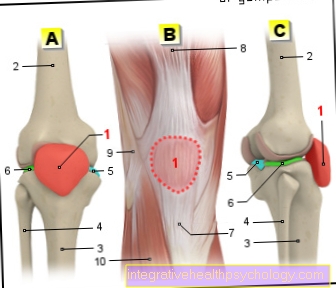Paracodin®
introduction

Paracodin® is a drug from the group of antitussives (cough suppressants) and is used for unproductive, dry cough. The active ingredient in Paracodin is dihydrocodeine.
Dihydrocodeine is a derivative of the opium alkaloid morphine and a derivative of codeine, which in turn is prescribed as an antitussive and pain reliever. Paracodin® falls under the Narcotics Act in Germany, which means that the dispensing of the drug is specially controlled.
Mode of action
The active ingredient dihydrocodeine contained in Paracodin® is an active ingredient from the group of Opioids. The term opioid refers to a group of natural and synthetic substances that act on Opioid receptors are effective.
The main effects of the opioids are strong analgesia (Pain relief), opioids continue to have a sedating and respiratory depressive effect (inhibit the respiratory drive) and can constipation (Constipation).
With prolonged use, the development of a Dependency possible. Dihydrocodeine has a strong analgesic effect; it is mainly used in short-term therapy to treat unproductive irritable coughs. It can also be used for moderate pain.
Side effects
The in Paracodin® The active ingredient dihydrocodeine can be used as an opioid receptor drug various side effects cause. It can increase after taking Paracodin® itching come with a reddening of the skin, this occurs in ? 0,1% of the cases.
Furthermore, heavier allergic reaction These can occur up to in their intensity up to Steven Johnson Syndrome swell (? 0,01% of the cases).
By taking Paracodin® there may be an increase in the muscle tone of the Smooth muscles come this can im Gastrointestinal tract lead to constipation.
Another side effect is nausea, up to Vomit, this occurs frequently at the start of therapy. Occasionally, dry mouth occurs.
Frequently (? 1% of the cases) it comes to light a headache and slight drowsiness, it can too sleep disorders occur.
As psychological side effects are partial euphoria and Mood swings observed. Also are States of confusion possible, too Cognitive disorders With Hallucinations occur (? 0,1%).
In patients with pre-existing epilepsy or the tendency to Seizures is the risk of during therapy with Paracodin® Convulsions (Cramps) increased (? 0,1%). Often the patients complain Dizziness.
At high doses are still Drops in blood pressure and evolving from it Syncope, so suddenly fainting, possible.
Also, patients who already have a Pulmonary dysfunction are predestined for this during high-dose therapy with dihydrocodeine Pulmonary edema to develop. In addition, breathing disorders may occur, dyspnoea (Shortness of breath) or one Respiratory depression (mostly with improper consumption of dihydrocodeine) are possible.
In general, it must be noted that long-term, high-dose therapy results in a tolerance developed against the drug and that mental and physical addiction arise.
The intake of Paracodin® with its active ingredient dihydrocodeine can in addition to a Deterioration of vision lead because the power of the Eye muscles can be reduced. Very rarely, eye dysfunction that manifests as Miosis (Constriction of the pupil) or Scotoma expresses (? 0,01%).
Contraindications and restrictions on use

Paracodin® or dihydrocodeine should not be used in certain diseases or conditions.
An important contraindication are certain Respiratory diseases, how Respiratory failure or Respiratory depressionbecause both are made worse by dihydriocodeine.
In addition, the drug should not be used in acute Asthma attack still with chronic bronchial asthma be taken. Even if the central switching center of breathing, i.e. the breathing center, is disturbed, dihydrocodeine preparations must not be taken.
Furthermore, dihydrocodeine is generally used in children younger than four years are contraindicated.
If the patient has a Dependency If there is opioids, alcohol or sedatives, dihydrocodeine therapy must be used very carefully, otherwise the dependency will worsen.
In patients who after a operative removal of the Gallbladder should be treated with dihydrocodeine, care should be taken.
In patients who have a impaired kidney function the dose needs to be adjusted as elimination is slowed.
Generally one should be in the treatment of elderly patients Be careful when using dihydrocodeine, as the therapy can affect existing pre-existing conditions. Particular care is taken in patients with pre-existing Hypothyroidism, impaired liver function and / or existing Seizure disorders (epilepsy) Consider dihydrocodeine therapy. Even with chronic constipation (constipation) caution is advised, as the opioid can tend to aggravate constipation.
Also in the pregnancy the intake of dihydrocodeine must be weighed very carefully. In the first three months During pregnancy it is possible to take the preparation with very strict indications. As soon as the birth is near, dihydrocodeine is given contraindicatedbecause there would be a risk of respiratory depression for the newborn.
Studies have shown connections between the intake of dihydrocodeine in pregnant women and malformations in children. In addition, if taken over a long period of time, a Developing dependency in the unborn child.
It has been used after birth in children whose mothers had repeatedly taken dihydrocodeine during pregnancy (in the last trimester) Withdrawal symptoms detected.
During the Lactation the intake of dihydrocodeine is contraindicated because the active ingredient passes into breast milk and can cause side effects in the infant.
Drug interactions
Dihydrocodeine is an im central nervous system active drug, therefore it may interact with others in brain and Spinal cord acting substances result.
When taking dihydrocodeine and central depressant drugs such as Sedatives, Sleeping pills or Psychotropic drugs the respiratory depressive and sedative effects of dehydrocodeine are increased.
The same effects can be obtained from the combined intake of Antihistamines and Hypertensive drugs with dihydrocodeine.
Also with tricyclic antidepressants dihydrocodeine should not be combined as respiratory depression is exacerbated. In general, the opioid should also not be used Painkillers can be combined as it increases the effectiveness of the pain relievers.
Another important interaction can arise when using dihydrocodeine and MAOIs together. In this case it can be too high fever, States of excitement and changes in breathing and des Circulatory come.
Finally, dihydrocodeine is allowed during therapy no alcohol consume, as this combination reduces psychomotor skills.
Symptoms of poisoning
The symptoms are very diverse. The most important is the pronounced Respiratory depression. Due to respiratory depression are one cyanosis, one Hypoxia and cold skin possible.
Furthermore, the poisoning (intoxication) affects various organ systems. It comes to Urine- and Stool retention, Vomit is possible.
Also a coma can occur with rigid pupils, here with Miosis (Constriction of the pupils). It can also be used for Loss of tone of the Skeletal muscles come, sometimes with non-response to stimuli that evoke the reflex (areflexia). Also a Drop in blood pressure With Bradycardia (slowed pulse rate) is possible. Cramps can also occur.





























